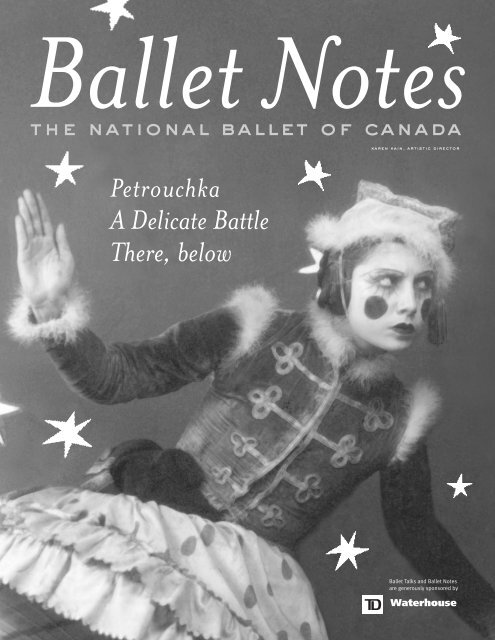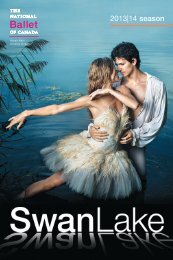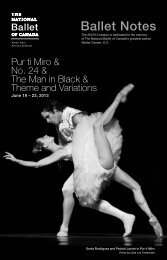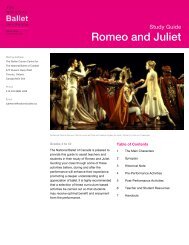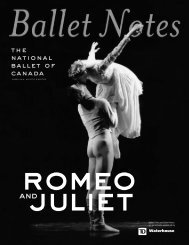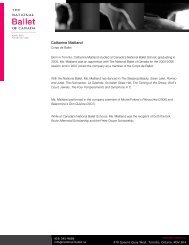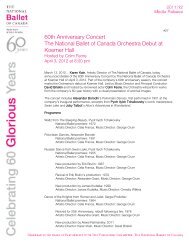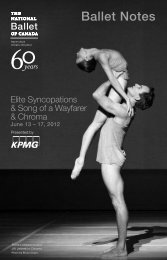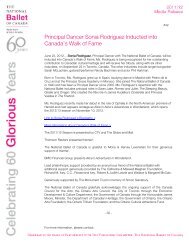Petrouchka Notes - The National Ballet of Canada
Petrouchka Notes - The National Ballet of Canada
Petrouchka Notes - The National Ballet of Canada
Create successful ePaper yourself
Turn your PDF publications into a flip-book with our unique Google optimized e-Paper software.
<strong>Ballet</strong> <strong>Notes</strong><br />
the national ballet <strong>of</strong> canada<br />
<strong>Petrouchka</strong><br />
A Delicate Battle<br />
<strong>The</strong>re, below<br />
karen kain, artistic director<br />
<strong>Ballet</strong> Talks and <strong>Ballet</strong> <strong>Notes</strong><br />
are generously sponsored by
A Delicate<br />
Battle<br />
Choreography Matjash Mrozewski<br />
Music J.S. Bach,<br />
Ricercar a 6 from <strong>The</strong> Musical Offering<br />
Gavin Bryars, After the Requiem<br />
Used by arrangement with European American Music<br />
Distributors LLC, sole U.S. and Canadian agent for Schott<br />
& Co. Ltd., London, publisher and copyright owner.<br />
Costume Design Christopher Read<br />
Lighting Design Christopher Dennis<br />
A Delicate Battle is a gift from THE VOLUNTEER<br />
COMMITTEE, THE NATIONAL BALLET OF CANADA<br />
<strong>The</strong>re,<br />
below<br />
Choreography James Kudelka<br />
Music Ralph Vaughan Williams,<br />
Fantasia on a <strong>The</strong>me by Thomas Tallis<br />
By arrangement with G. Schirmer Inc. agents<br />
in the United States for J. Curwen & Sons,<br />
publisher and copyright owner.<br />
Costume Design Claudia Lynch<br />
Lighting Design Howell Binkley<br />
<strong>The</strong>re, below is made possible by a generous<br />
gift from <strong>The</strong> Harbinger Foundation.<br />
For C.A.P.
<strong>Petrouchka</strong><br />
Choreography Michel Fokine<br />
Performed with the permission<br />
<strong>of</strong> the FOKINE ESTATE-ARCHIVE<br />
Staged by Gary Chryst<br />
Music Igor Stravinsky<br />
By arrangement with Boosey and Hawkes,<br />
Inc. publisher and copyright owner.<br />
Production owned by Les Grands<br />
<strong>Ballet</strong>s Canadiens de Montréal<br />
Set and costumes courtesy <strong>of</strong><br />
Les Grands <strong>Ballet</strong>s Canadiens<br />
de Montréal after the original<br />
concept by Alexandre Benois<br />
Costume research and<br />
coordination Kim Baker<br />
Assisted by John Cowell<br />
Lighting Design<br />
Christopher Dennis<br />
<strong>Petrouchka</strong> is made possible by generous<br />
funding from Nancy Pencer & Michael<br />
Benjamin and Imperial Tobacco <strong>Canada</strong>.<br />
cover: tamara toumanova in 1934 production<br />
<strong>of</strong> petrouchka by monte carlo ballet russes.<br />
this page: aleksandar antonijevic in petrouchka.<br />
opposite: top: christopher body and laura bolton<br />
in a delicate battle. bottom: tanya howard<br />
and nehemiah kish in <strong>The</strong>re, below.<br />
photos by cylla von tiedemann, andrew oxenham,<br />
corbis images<br />
the national<br />
ballet <strong>of</strong> canada<br />
<strong>The</strong> Walter Carsen Centre for<br />
the national ballet <strong>of</strong> canada<br />
470 Queens Quay West, Toronto,<br />
Ontario m5v 3k4 416-345-9686<br />
national.ballet.ca<br />
cover photo: guillaume côté as romeo and heather ogden as juliet,<br />
opposite: guillaume côté as romeo, peter ottmann as friar laurence and<br />
heather ogden as juliet.
goat<br />
the characters in<br />
<strong>Petrouchka</strong><br />
<strong>Petrouchka</strong><br />
Created by the Charlatan, <strong>Petrouchka</strong> is a clown-like puppet that comes<br />
to life and is tormented by his unrequited desire for the Ballerina doll.<br />
Happiness is illusive to him and as he dances his movements are floppy<br />
and turned in to represent his painfully introverted personality.<br />
<strong>Petrouchka</strong> tries to impress the Ballerina with a series <strong>of</strong> magnificent<br />
leaps, but is scorned when she ignores him, preferring his rival the<br />
Moor. Alone in his dark cell he is filled with frenzied despair. To highlight<br />
this character’s eternal struggle, Stravinsky created a fanfare motif<br />
for <strong>Petrouchka</strong> that appears throughout the ballet, and with great effect<br />
at the end, as <strong>Petrouchka</strong>’s ghost appears to mock the crowd. <strong>Petrouchka</strong>,<br />
the tragic hero, triumphs over those who did not believe in him.<br />
<strong>The</strong> Ballerina<br />
<strong>The</strong> Ballerina doll is very beautiful, but lacks depth <strong>of</strong> personality.<br />
She ignores <strong>Petrouchka</strong>’s sincere advances because she is dazzled by<br />
the more opulent and exotic Moor. Her mechanical movements are<br />
meant to be inhuman and bare, unlike stereotypical ballerina movements.<br />
Her thoughtless actions have fatal consequences for <strong>Petrouchka</strong>.<br />
<strong>The</strong> Moor<br />
Alive in his red cell, adorned with exotic motifs, the virile Moor is more<br />
interested in the secrets that might be held in the coconut he possesses<br />
than the silly flirtations <strong>of</strong> the Ballerina doll. He momentarily acknowledges<br />
her affections, but flies into a fury when interrupted by <strong>Petrouchka</strong>.<br />
His movements throughout the ballet are turned out to represent his<br />
expansive, extroverted personality. It is the Moor’s cold brutality that<br />
leads him to murder the defenceless <strong>Petrouchka</strong>.<br />
<strong>The</strong> Charlatan<br />
A showman and magician <strong>of</strong> questionable integrity, the Charlatan has<br />
endowed the <strong>Petrouchka</strong>, Ballerina and Moor dolls with many human<br />
attributes. Remaining under his control the half puppets/half human<br />
beings suffer real human emotions like sadness, love, lust, jealousy and<br />
rage with tragic outcomes for all.<br />
SYNOPSIS<br />
<strong>The</strong> story, which unfolds in four scenes, takes place in St. Petersburg in 1830<br />
during the annual Butterweek Fair, the Russian equivalent to Mardi Gras. <strong>The</strong><br />
first scene opens on a square filled with a rowdy crowd <strong>of</strong> peasants, aristocrats,<br />
soldiers, street performers, vendors, and various others, all seeking amusements<br />
and diversion. <strong>The</strong>ir activities are interrupted by the appearance <strong>of</strong> a bearded<br />
showman, the Charlatan, who presents his three puppets – the doll-like Ballerina,<br />
the opulent Moor, and the sad <strong>Petrouchka</strong> – performing a mechanical dance.<br />
Scene Two takes place in <strong>Petrouchka</strong>’s dark cell, dominated by a watchful portrait<br />
<strong>of</strong> the Charlatan, and reveals the puppet’s awkward and despairing love for the<br />
self-involved and uncomprehending Ballerina. Scene Three shifts to the Moor’s<br />
colourful room. <strong>The</strong> Moor plays with a coconut and momentarily allows the<br />
admiring Ballerina to distract him. His rage at <strong>Petrouchka</strong>’s entrance results in<br />
a chase. In the final scene, back at the fair, <strong>Petrouchka</strong> runs out <strong>of</strong> the Charlatan’s<br />
booth, followed by the Moor, who kills him. <strong>The</strong> crowd is horrified, but the<br />
Charlatan picks up the limp puppet, convincing them that the corpse is just<br />
sawdust and rags. As the fair ends, the ghost <strong>of</strong> <strong>Petrouchka</strong> appears above the<br />
ro<strong>of</strong>top, both threatening and triumphant. <strong>The</strong> bewildered Charlatan drops<br />
the doll and flees in terror.<br />
costume designs by alexandre benois for the<br />
original 1911 production <strong>of</strong> petrouchka.<br />
charlatan
a note on<br />
<strong>Petrouchka</strong><br />
From 1909 to 1929 impresario Serge Diaghilev revolutionized ballet<br />
by bringing together and nurturing the best choreographers, composers,<br />
dancers and stage designers <strong>of</strong> this era. Diaghilev’s <strong>Ballet</strong>s Russes presented<br />
season after season <strong>of</strong> avant-garde, controversial and enduring ballets.<br />
<strong>Petrouchka</strong>, created in 1911, is generally acknowledged as being the most<br />
perfect <strong>of</strong> all the <strong>Ballet</strong>s Russes creations with a unified concept brought<br />
together through the close collaboration <strong>of</strong> the creators.<br />
It was after the success <strong>of</strong> <strong>The</strong> Firebird in 1910, that Diaghilev approached<br />
composer Igor Stravinsky about creating a new ballet. Stravinsky was already<br />
working on a suite for piano and orchestra based on the <strong>Petrouchka</strong> character,<br />
a traditional member <strong>of</strong> the Russian commedia dell’arte. Diaghilev<br />
suggested that Stravinsky continue work on <strong>Petrouchka</strong> in collaboration with<br />
scenic designer Alexandre Benois, who also had a great knowledge <strong>of</strong> Russian<br />
history and culture. Together Stravinsky and Benois worked out the libretto<br />
for <strong>Petrouchka</strong>, each giving credit to the other for being the ballet’s true author.<br />
It was not until the libretto and the music were completed that choreographer<br />
Michel Fokine joined the creative team to instill each character with a fusion<br />
<strong>of</strong> choreography and mime that related directly to the libretto.<br />
<strong>The</strong> ballet plays with issues <strong>of</strong> life and death, fantasy and reality, while also<br />
presenting a semblance <strong>of</strong> authentic Russian folk culture. It is noted that<br />
Fokine insisted every person in the crowd scenes be a distinctive character,<br />
something he felt Stravinsky also illustrated in his blend <strong>of</strong> folk tunes for the<br />
music. <strong>The</strong>refore, every segment <strong>of</strong> society is represented at St. Petersburg’s<br />
Butterweek Fair, from military <strong>of</strong>ficers and aristocratic families to gypsies<br />
and drunkards. <strong>The</strong> result is one <strong>of</strong> the most vibrant and varied crowd scenes<br />
ever seen on stage. Benois went on to confuse the boundaries between performance<br />
and reality by creating a false proscenium on stage to give the idea<br />
that the audience was watching a play within a play.<br />
<strong>Petrouchka</strong> premiered in Paris at the Théâtre du Châtelet on June 13, 1911.<br />
Opening night featured Vaslav Nijinsky as <strong>Petrouchka</strong>, Tamara Karsarvina<br />
as the Ballerina, Alexandre Orlov as the Moor and Enrico Cecchetti as the<br />
Charlatan. With every element organically connected, the Paris premiere<br />
was a success and <strong>Petrouchka</strong> remained active in the <strong>Ballet</strong>s Russes’ repertoire<br />
until the last season in 1929. It was the first time audiences were gripped<br />
by the pr<strong>of</strong>ound tragic nature <strong>of</strong> the action, not the dances themselves.<br />
Nijinsky elicited immediate acclaim and awe for his ability to portray<br />
<strong>Petrouchka</strong>, the puppet, with enough spirit to defy death. Known for his<br />
amazing technical ability, this role demonstrated Nijinsky’s intense acting<br />
ability. <strong>The</strong> audiences saw neither a puppet nor a man, but a mixture <strong>of</strong><br />
both. He imparted <strong>Petrouchka</strong> with tragic nuances from the depths <strong>of</strong> his<br />
own genius. With or without the stage makeup, it seems that Nijinsky truly<br />
understood <strong>Petrouchka</strong>’s plight. <strong>The</strong>re is much speculation about the<br />
parallel relationships between <strong>Petrouchka</strong> and the Charlatan and Nijinsky<br />
and Diaghilev.<br />
<strong>Petrouchka</strong> is new to the repertoire <strong>of</strong> <strong>The</strong> <strong>National</strong> <strong>Ballet</strong> <strong>of</strong> <strong>Canada</strong> in 2006,<br />
however it had come close to being presented in the late 1970s. In 1978,<br />
Tom Patterson (Founder <strong>of</strong> the Stratford Festival) approached the <strong>National</strong><br />
<strong>Ballet</strong> with plans to mount a film version <strong>of</strong> <strong>Petrouchka</strong>. Much <strong>of</strong> the production<br />
was to be filmed outdoors in St. James Park, which was across from St.<br />
Lawrence Hall, the company’s rehearsal studios at the time. Rudolf Nureyev<br />
was contacted to star in the production.<br />
ballerina<br />
court<br />
coachman<br />
Nicholas Berioz<strong>of</strong>f came to Toronto to teach the revival <strong>of</strong> Fokine’s choreography to the company, however funding for completion<br />
<strong>of</strong> the project never came through and the plan for the <strong>Petrouchka</strong> film died. In 1981 Nureyev revived <strong>Petrouchka</strong> with the J<strong>of</strong>frey <strong>Ballet</strong><br />
and it was filmed by PBS. Unfettered by the budget constraints <strong>of</strong> the company, Berioz<strong>of</strong>f suggested the <strong>National</strong> <strong>Ballet</strong> mount his<br />
version <strong>of</strong> Don Quixote and proposed several ways to make it affordable. Don Quixote made the stage on November 10, 1982.
A note on<br />
A Delicate Battle<br />
When Matjash Mrozewski’s A Delicate Battle<br />
first premiered with the <strong>National</strong> <strong>Ballet</strong><br />
on May 2, 2001, it was hard to believe that<br />
such a vivid, poised and elegantly constructed<br />
work was the creation <strong>of</strong> such a<br />
young choreographer. Here was a talent<br />
with a sure command <strong>of</strong> the grammar <strong>of</strong><br />
dance and the confidence <strong>of</strong> a much more<br />
experienced artist.<br />
In A Delicate Battle, Mrozewski employs a<br />
controlled and supple neo-classical vocabulary<br />
to explore the nature <strong>of</strong> the artistic<br />
process. Deftly blending abstraction and<br />
narrative, and merging in an imaginative<br />
crucible the past and present, Mrozewski<br />
locates the struggles – large and small –<br />
that go into the shaping <strong>of</strong> artistic work<br />
and artistic integrity.<br />
Set in a cool, neutral and wintry scene,with<br />
J.S. Bach’s Musical Offering and Gavin Bryar’s<br />
contemporary After the Requiem providing<br />
the musical context, Mrozewski’s dancers<br />
traverse a range <strong>of</strong> styles and moods, with<br />
echoes <strong>of</strong> the baroque and the contemporary<br />
brought together into the work’s<br />
unifying idea: art arises from conflict<br />
and struggle.<br />
A chamber work with symphonic resonance,<br />
A Delicate Battle provides an exciting glimpse<br />
into the future <strong>of</strong> Canadian ballet.
A note on<br />
<strong>The</strong>re,below<br />
James Kudelka’s reputation as one <strong>of</strong> contemporary ballet’s modern<br />
masters was established early in his career. While much <strong>of</strong> his standing<br />
rests on the works he has choreographed for <strong>The</strong> <strong>National</strong> <strong>Ballet</strong><br />
<strong>of</strong> <strong>Canada</strong> which include such seminal works as Pastorale, <strong>The</strong> Actress,<br />
<strong>The</strong> Four Seasons, Swan Lake, <strong>The</strong> Firebird and <strong>The</strong> Contract (<strong>The</strong>Pied Piper),<br />
his many works for other companies contain choreographic riches<br />
to match these.<br />
<strong>The</strong>re, below was created for <strong>Ballet</strong>Met in Columbus, Ohio in 1989<br />
and was enthusiastically received. Barbara Zuck <strong>of</strong> the Columbus<br />
and Dispatch wrote <strong>of</strong> the premiere, “Kudelka has deftly crafted a<br />
choreographic understatement that speaks volumes…<strong>The</strong> couples,<br />
each with their own movement motifs, move effortlessly and silently,<br />
as though removed by some great distance from the weight <strong>of</strong> worldly<br />
concerns. Each pair engages in remarkable pas de deux sometimes<br />
expressing in detail the phrasing <strong>of</strong> the music, sometimes barely<br />
moving as the music pulses.”<br />
Set to Ralph Vaughan Williams’ haunting Fantasia on a <strong>The</strong>me<br />
by Thomas Tallis, <strong>The</strong>re, below is a series <strong>of</strong> elegantly and sparely<br />
constructed pas de deux, whose severity and simplicity serve as a<br />
counterpoint to the lushness and romantic yearning <strong>of</strong> the score.<br />
<strong>The</strong> tension between the rigorous abstraction <strong>of</strong> the choreography<br />
and the sumptuousness <strong>of</strong> the music creates an unsettling and<br />
unearthly feeling <strong>of</strong> dislocation.<br />
Kudelka has also staged <strong>The</strong>re, below for the Houston <strong>Ballet</strong>, <strong>Ballet</strong><br />
British Columbia and Les Grands <strong>Ballet</strong>s Canadiens de Montréal.<br />
<strong>The</strong> Vancouver Courier wrote “<strong>The</strong>re, below, James Kudelka’s 1989 gem<br />
<strong>of</strong> a piece…is another wrenchingly beautiful example <strong>of</strong> spirit made<br />
flesh... It flows along on an unstoppable wave <strong>of</strong> mighty sound,<br />
complementing the intense intimacy <strong>of</strong> the choreography.”<br />
opposite from left: rebekah rimsay and patrick lavoie in a delicate battle; alejandra<br />
perez-gomez in a delicate battle. this page both images: aleksandar antonijevic and<br />
sonia rodriguez in <strong>The</strong>re, below.


